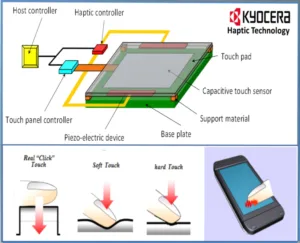Kyocera Fineceramics GmbH (Esslingen, Germany) has announced development of a technology that can provide “real touch feeling and force feedback” from display screens. Kyocera calls its new technology “Haptivity.”
Details of the technology are documented in a European Patent entitled “Input Apparatus and Control Method of Input Apparatus.” It has been assigned number EP 2 461 233 B1 and can be found on-line here.
The problem addressed by Kyocera with Haptivity derives from the fact that, on conventional display panels, the touch sensors themselves are not physically displaced when they are touched. This, in turn, leads to the well-known observation that insufficient touch feel and feedback can cause users to depend on a visual check or the need for an audible response to assure that a desired input has indeed been registered. This situation is not optimal and has been found to lead to mistaken operations.
The new touch technology developed by Kyocera is intended to give the display screen the ability to provide the sensation that it contains a mechanical keyboard. The approach utilized by Kyocera to accomplish this is based on features of human physiology. That is, tactile sensory awareness derives from specific types and sequences of nerve stimulation. A pressure sensation produces a tactile sensation that allows determination of object qualities such as the hardness or softness of an object. The texture of an object derives from vibrations on the skin surface when the object is touched.
Haptivity produces the desired impulses in the user’s finger by means that generates both pressure and specified vibration frequencies. More specifically, Kyocera simulates desired tactile sensations by stimulating the Pacini nerve in the finger. The stimulation is a two-step process. As an example, consider pressing a button. The first stimulation consists of a pressure feeling accomplished just by a micro-movement of the surface. This is followed by a subsequent stroke-down impression. This approach has been found to create the sensation in the brain of having pressed a real button.
The configuration of the device used to create desired sensations is illustrated in the figure below. As shown, the touch is detected by a capacitive touch sensor. The controller analyzes the nature of the touch and the desired stimulation is produced by piezo-electric devices.
The program executed by the software determines the nature of the simulation. The sequence of “special pressure detection and frequency can produce the feeling of pushing a normal button, a rubber-like key, an increment wheel and much more without a big movement of the surface of the panel.”
Kyocera stated that the new touch technology will be used within products offered by the company. In addition, the company is considering a program to license the technology. -Arthur Berman
Kyocera Fineceramics GmbH, Daniela Faust, +49 2131/16 37 X188, [email protected]

